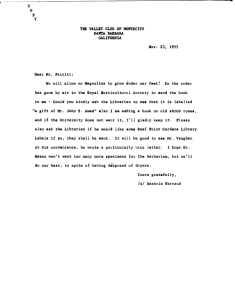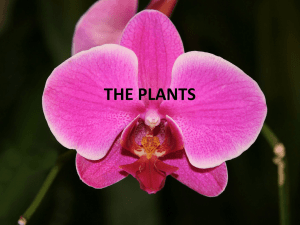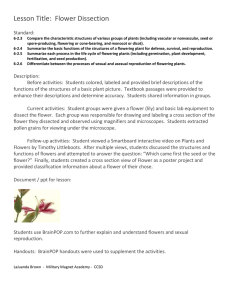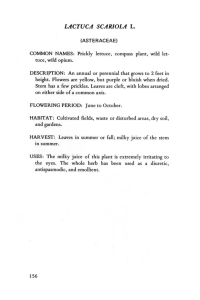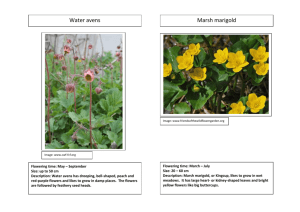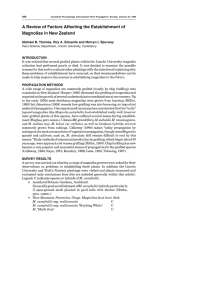Observations on magnolias at Lincoln University
advertisement
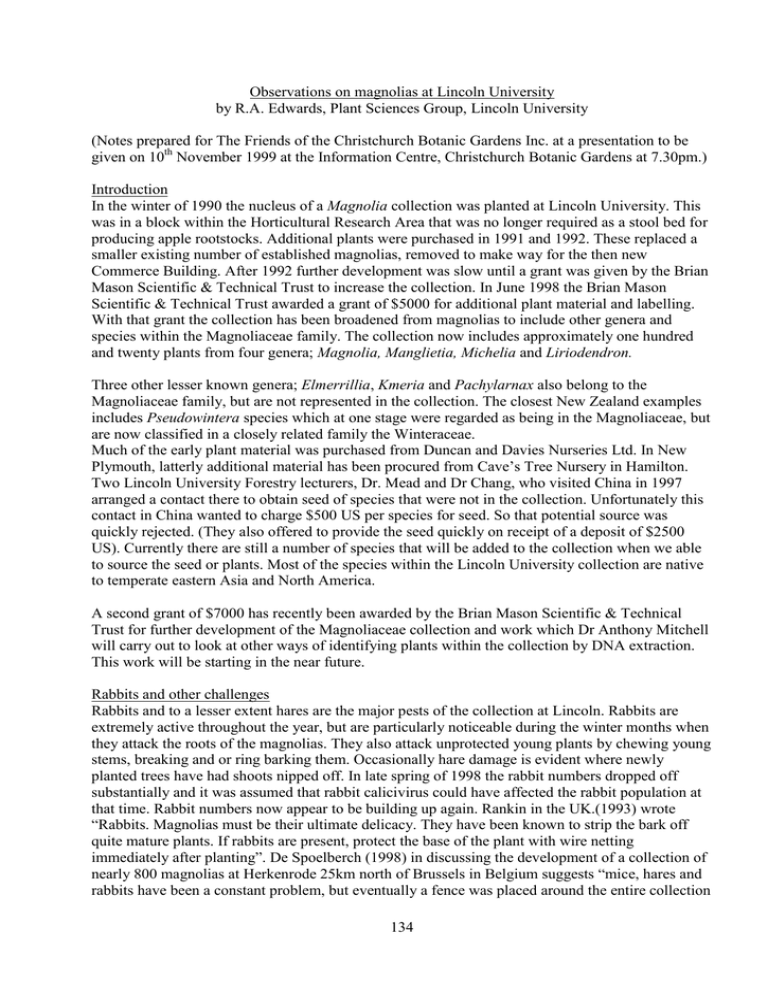
Observations on magnolias at Lincoln University by R.A. Edwards, Plant Sciences Group, Lincoln University (Notes prepared for The Friends of the Christchurch Botanic Gardens Inc. at a presentation to be given on 10th November 1999 at the Information Centre, Christchurch Botanic Gardens at 7.30pm.) Introduction In the winter of 1990 the nucleus of a Magnolia collection was planted at Lincoln University. This was in a block within the Horticultural Research Area that was no longer required as a stool bed for producing apple rootstocks. Additional plants were purchased in 1991 and 1992. These replaced a smaller existing number of established magnolias, removed to make way for the then new Commerce Building. After 1992 further development was slow until a grant was given by the Brian Mason Scientific & Technical Trust to increase the collection. In June 1998 the Brian Mason Scientific & Technical Trust awarded a grant of $5000 for additional plant material and labelling. With that grant the collection has been broadened from magnolias to include other genera and species within the Magnoliaceae family. The collection now includes approximately one hundred and twenty plants from four genera; Magnolia, Manglietia, Michelia and Liriodendron. Three other lesser known genera; Elmerrillia, Kmeria and Pachylarnax also belong to the Magnoliaceae family, but are not represented in the collection. The closest New Zealand examples includes Pseudowintera species which at one stage were regarded as being in the Magnoliaceae, but are now classified in a closely related family the Winteraceae. Much of the early plant material was purchased from Duncan and Davies Nurseries Ltd. In New Plymouth, latterly additional material has been procured from Cave‟s Tree Nursery in Hamilton. Two Lincoln University Forestry lecturers, Dr. Mead and Dr Chang, who visited China in 1997 arranged a contact there to obtain seed of species that were not in the collection. Unfortunately this contact in China wanted to charge $500 US per species for seed. So that potential source was quickly rejected. (They also offered to provide the seed quickly on receipt of a deposit of $2500 US). Currently there are still a number of species that will be added to the collection when we able to source the seed or plants. Most of the species within the Lincoln University collection are native to temperate eastern Asia and North America. A second grant of $7000 has recently been awarded by the Brian Mason Scientific & Technical Trust for further development of the Magnoliaceae collection and work which Dr Anthony Mitchell will carry out to look at other ways of identifying plants within the collection by DNA extraction. This work will be starting in the near future. Rabbits and other challenges Rabbits and to a lesser extent hares are the major pests of the collection at Lincoln. Rabbits are extremely active throughout the year, but are particularly noticeable during the winter months when they attack the roots of the magnolias. They also attack unprotected young plants by chewing young stems, breaking and or ring barking them. Occasionally hare damage is evident where newly planted trees have had shoots nipped off. In late spring of 1998 the rabbit numbers dropped off substantially and it was assumed that rabbit calicivirus could have affected the rabbit population at that time. Rabbit numbers now appear to be building up again. Rankin in the UK.(1993) wrote “Rabbits. Magnolias must be their ultimate delicacy. They have been known to strip the bark off quite mature plants. If rabbits are present, protect the base of the plant with wire netting immediately after planting”. De Spoelberch (1998) in discussing the development of a collection of nearly 800 magnolias at Herkenrode 25km north of Brussels in Belgium suggests “mice, hares and rabbits have been a constant problem, but eventually a fence was placed around the entire collection 134 and the rabbits and hares shot.” He goes on to suggest “mice can ring bark plants where mulch or ground cover plants grow up to the base of the trees and provide shelter and protection”. On rabbits again “In parks which have become rabbit infested, big magnolia shrubs and even old trees of Magnolia acuminata and Liriodendron tulipifera will be completely ringed over one winter by starving rabbits. It is quite extraordinary to see the thick bark of a Liriodendron patiently scraped away until the last tender cambium layer can be reached”. Any new plantings of the Magnoliaceae at Lincoln University are now routinely protected with wire cages for a few months as a protection against rabbits and hares. Shooting has also been carried out in the past. Magnolia production systems It appears that most magnolias are grafted on to rootstocks of seedlings. From my experience to date this may not produce the best results and there have been many instances of magnolias that have shown reversion to the rootstocks. This is easily observable when the plants are in flower as two different types of flowers or colours may appear on the same plant. In one specific instance where a plant of Magnolia acuminata „Golden Glow‟ was grown it flowered the second and third year from planting, but the scion died after flowering in the third year. In the spring of the third flowering I observed a black exudate oozing from the point of the graft union. While I did not do anything about this at the time, it appeared to me that this was indicative of delayed graft incompatibility. The rootstock however did not die and has since flowered with extremely large flowers that appear to be of Asiatic hybrid parentage. The flowers of this rootstock are up to 270mm across and unlike any other Magnolia x soulangeana I am familiar with. Magnolia acuminata however is a North American species. (Recent DNA analysis work by Dr Mitchell at Lincoln University has shown this to be a Magnolia x soulangeana hybrid). In discussing the ethics of selecting rootstocks, J.G. Millais in his 1927 monograph -the first ever written on magnolias, states. “Those who are forming gardens should always give magnolias their first consideration when planting, and put in two or three examples of all the best species and hybrids that can be procured on their own roots”. From my observations so far I would endorse that suggestion and encourage nurserymen to consider trying cutting grown plants as an option, rather than grafted plants. Wilkinson (1978) however, suggests genera such as Magnolia are notoriously difficult to produce roots from cuttings. If grafting is to be considered necessary, then at least use rootstock species that closely match the scion. More recent authors such as Callaway (1994) suggest most of the magnolias grown today are from cuttings. De Spoelberch (1998) states “Too many magnolias in old collections are but stock which has sprouted back after the scion has been killed by frost. Cuttings are much better than grafted material, more than half of our accessions are cuttings taken from the plants that have performed best here”. Pruning To date very little pruning has been carried out on any of the magnolias in the collection with the exception of storm damage, weak crotch angles or removing errant rootstock growth that has developed at the expense of the scion. The latter has usually been cut from tagged branches soon after flowering. The different flowers of the rootstock and scion make it easy to select the material for removal. In a few cases, some heavy pruning has been carried out to remove branches with weak crotch angles to prevent future problems. Where heavy pruning has been carried out there has been a response by the plants in producing a large number of shoots. These need to be cut out very early. It is better to avoid heavy pruning by correcting branch angles or removing unwanted shoot growth as early as possible. Flower initiation for most spring flowering magnolias appears to occur in early summer so to avoid potential flower loss, prune as soon after flowering as possible. De Spoelberch, 1998 states “Pruning is essential when transplanting magnolias and removal of most of the lateral branches is carried out leaving only one leader, even if the plant will end up as a shrub.” 135 Flowering Since 1998 I have been fortunate to have Mr Bruce Palmer work on a voluntary basis to assist with the management of the area. Bruce also undertook to record the magnolias in flower once a week. Flower records were based on an estimate of flowering for each plant in flower on that day. From those records information has been put into a database and a graph for each species showing expected flowering times can be produced. By aggregating all of the flowering records kept for 1998 together, the best two weeks to have visited Lincoln in 1998 to view magnolias was in the weeks starting the 21st and 28th September. For 1999 the best two weeks started the 20th and 27th September. Bruce Palmer is continuing to record magnolia flowering this year at Lincoln University and Kristian Davies of the Auckland Botanic Gardens kept flowering records of Magnolia kobus var. stellata „King Rose‟ for 1999. This has enabled us to get an overview of the likely differences in flowering period by comparing the same cultivar between the two sites. Aggregation of all magnolia flowering dates 5000 4000 3000 2000 1000 3/11/1998 2/11/1998 26/10/1998 19/10/1998 12/10/1998 5/10/1998 28/09/1998 21/09/1998 14/09/1998 31/08/1998 7/09/1998 0 24/08/1998 Est. of Percentage flowering 10week period in 1998) Observation date Aggregation of all magnolia flowering dates 5000 4000 3000 2000 1000 Observation date 136 1/11/1999 25/10/1999 18/10/1999 11/10/1999 4/10/1999 27/09/1999 20/09/1999 13/09/1999 6/09/1999 30/08/1999 0 23/08/1999 Est. of Percentage flowering 10week period in 1999) Once we have sufficient flowering records, flowering times can be compared with past climate data and we may then be able to predict when flowering will occur on the basis of heat unit accumulation after flower initiation. Comparisons of flowering times with other species at Lincoln University and with Auckland Botanic Gardens and with climatic data of both regions to determine heat unit accumulation will help fine tune the results. From observations to date it is possible to have some magnolias in flower in Canterbury from July to May, nine to ten months of the year. Frost damage to flowers Early flowering plants can be susceptible to damage by frost. Frost damage is observed as a browning or blackening of the perianth prematurely, effectively reducing the amenity values of that plant. The tepals (tepal is a term coined by Johnstone for units of the perianth that are indistinguishable as either sepals or petals. The outer hairy units are perules, which enclose spathaceous bracts outside of the tepals. (Treseder, 1978) then fall within a few days. From my observations not all flowers open at once, flowering is usually a progressive event and frost damage tends to only destroy the flowers that are open, buds enclosed by the large hairy perules seem to be protected and these subsequently open later. If the temperatures remain low for a few days it appears as though flowering is also delayed, resuming as temperatures increase. The most severe frost damage is usually in September although this year with very early flowering of Magnolia „Serene‟ frost damage has been observed in late July. The second flush of flowering then appeared to delay for a period of about ten days before flowering resumed. Pollination and seed set A number of seedlings grew during the last summer. These were tagged with the intention of lifting and bagging the seedlings in the early winter. Rabbits or hares it seems took every seedling in late autumn 1999, leaving just a few decapitated seedlings as evidence. This summer Magnolia sieboldii has produced numerous seedlings (approx. 80 plants have been potted up) growing in the bark mulch beneath the branch spread. Any other tree in the collection has only ever produced a few seedlings at most. Magnolias are protogynous plants, the carpels mature before the anthers are ready to release pollen within the same flower. In order for pollination to occur pollen must then be brought from another flower where the stamens have released pollen. Soon after the pollen has been released from the stamens appear to collapse. At this stage thrips, honey bees and a type of fly have been observed on the flowers. Selecting the „best‟ Rankin, 1993 states “I was once told by an eminent plantsman that „every magnolia is beautiful yet some are superior.” There appears much truth in that statement, my personal favourites are the Asiatic magnolias as a group and within those there are many fine options. In terms of beauty M. sprengeri „Diva‟ has always impressed me, for fragrance M. x weisneri is superb. In terms of beauty and reliability in Canterbury the M. x soulangeana and M. stellata are hard to beat. This brief summary however leaves out M. denudata and M. liliiflora both of which are hardy in Canterbury and beautiful in their own right. As an aside these are the parents of M. x soulangeana from which a number of fine cultivars have been selected. How do you leave out of any discussion of magnolias the early flowering magnolias such as M. campbellii or the serenely beautiful flowers of M. sargentiana? At this point I should give up, but in finishing will briefly touch on some of the NZ raised hybrids such as those of Felix Jury, plants such as M. „Serene‟, M. „Vulcan‟. M. „Iolanthe‟, M. „Apollo‟ and M. „Mark Jury‟ to name but a few. These are all large flowered hybrids. Others such as „Star Wars‟ (a NZ. cultivar selected by Oswald Blumhardt) and „Royal Crown‟ greatly extend the flowering period and all are well worth growing. For something different the large leafed M. macrophylla flowers in late November and into December. This plant has deep pudding plate shaped flowers to about 25cm in diameter. All the above covered are white, cream or pink shades 137 through to deep rich purple. There are other magnolias now available that have yellow flowers. Flowers such as those of M. acuminata „Golden Glow‟, M. „Yellow Fever‟ (an unfortunate name), M. „Elizabeth‟ and M. „Yellow Bird‟ are possibilities worth growing. M. acuminata one of the parents of most of the yellow flowered hybrids is a deciduous North American tree which needs a lot of space. Another North American species well worth space in the garden is M. grandiflora. This species is evergreen and produces large lemon scented flowers over the summer, a few at time until frosts occur. There are also number of selected cultivars of M.grandiflora as well as hybrids between this and M. virginiana another North American species. Picture of „unknown‟ rootstock of Magnolia acuminata „Golden Glow‟, recent DNA analysis by Dr Mitchell has shown the rootstock to be a Magnolia x soulangeana hybrid. References 1. Callaway, Dorothy, J. (1994) „The world of Magnolias‟ Timber Press, Portland, Oregon. 2. De Spoelberch, Phillipe „Growing magnolias in Belgium‟ pp.201-230 in „Magnolias and their allies‟ Hunt, David (Editor) Proceedings of an International Symposium, Royal Holloway, University of London, Egham, Surrey, U.K., 12-13th April 1996 and published for the International Dendrology Society and The Magnolia Society 1998. 3. Millais, J.G. (1972) „Magnolias‟ Minerva Press, first published 1927. 4. Rankin, G. (1993) „Chalices of spring and summer‟ in The Garden‟ June, pp.252-257. 5. Treseder, N.G. (1978) „Magnolias‟ Faber and Faber, London, Boston. 6. Wilkinson, J. (1978) cited in „Magnolias‟ by Treseder, N.G. „Cytological Considerations‟ pp.209-212. Faber and Faber, London, Boston. 138


